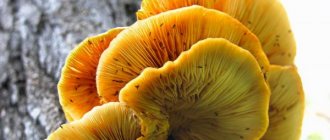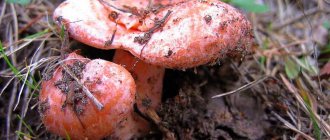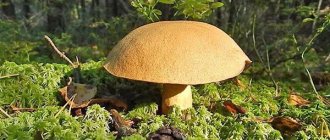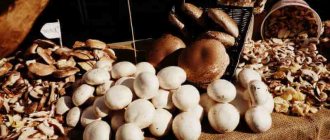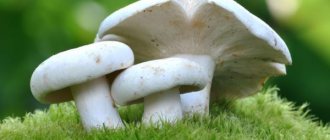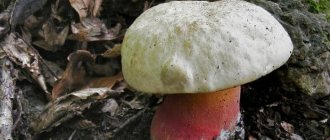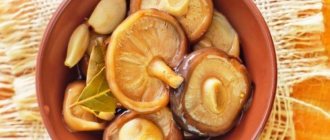| Latin name: | Lactarius torminosus |
| English name: | Coral milky cap |
| Domain: | Eukaryotes |
| Kingdom: | Mushrooms |
| Department: | Basidiomycetes |
| Class: | Agaricomycetes |
| Order: | Russulovidae |
| Family: | Russula |
| Genus: | Milky |
| Edibility | Edible mushroom |
Volnushki grow in birch and mixed forests until October. There are white and pink waves in color, and they also differ in the size of the cap. When the mushroom is cut, a very thick, oily, burning juice is released. This characteristic feature creates difficulties for preparing dishes from volushki.
- 6.1 Pink trumpet (Lactrius torminsus)
- 7.1 Lactarius spinosulus
Characteristics of the wave
hat
The cap of the moth reaches 12 cm in diameter. In a young mushroom it is convex in shape, but gradually flattens, leaving a small depression in the center of the cap. The edges of the cap are turned down and slightly pubescent. There is a vague concentric pattern on the skin of the cap. The color of the cap ranges from light pink to pure white. The skin is slimy. After touching, dark spots remain on the skin.
Pulp
— Advertising —
The pulp is white, dense, strong, making the mushroom easy and convenient to transport over long distances. It tastes islandy. The milky juice is white, does not change color when oxidized, and is released abundantly.
Leg
The height of the leg is about 6 cm, the diameter is up to 2 cm, the color is light pink. A young mushroom has a dense, solid stalk, while a mature mushroom has a hollow stalk. There are small grooves and slight pubescence on the surface of the stalk.
How to process and prepare fried mushrooms marinated with cloves
Pickled mushrooms occupy a special place among the appetizers on the festive table. How to properly process and prepare fried mushrooms marinated with cloves?
- 2 kg of mushrooms;
- 500 ml water for marinade;
- 1 tbsp. l. salt;
- 1.5 tbsp. l. Sahara;
- 7-10 cloves;
- 3 leaves each of laurel and allspice;
- 70% vinegar essence.
A step-by-step recipe will show you how to prepare pickled trumpets with cloves. Let us remind you that the processing includes not only preliminary cleaning, but also proper boiling of the mushrooms.
- Peel the mushrooms, cut off the ends of the stems, place in boiling salted water with the addition of citric acid and boil for 20 minutes. over medium heat.
- When foam appears, be sure to remove it with a slotted spoon.
- Add halved onions to the water and boil for 10 minutes.
- Catch the mushrooms and place in an enamel pan with boiling marinade.
- Marinade: boil water, add salt, sugar, allspice, bay leaf and cloves.
- Boil for 5 minutes, boil the mushrooms in the marinade for 15 minutes, distribute into jars and pour over the marinade.
- Pour ½ tsp into the mushrooms on top. vinegar essence (for a 0.5 liter jar), roll up and turn over.
- Cover with a blanket and leave the mushrooms to cool for 12-14 hours.
- Place in a cool, dark place for long-term storage.
Edibility of the trumpet
Volnushka is a conditionally edible mushroom of good quality. The peoples of the north often prepare volushka for the winter. In Central and Southern Europe, this mushroom is not eaten. And, for example, in Finland, they blanch for 5-10 minutes, fry and use in the preparation of first and second courses.
Volnushka is a difficult mushroom to prepare due to the bitter juice it contains. Therefore, the wave is well soaked in salted water.
Volushka is eaten salted and pickled, and also fresh in main courses. These mushrooms are great for frying and making sauces for meat and vegetables. Volushki are also good as a side dish: simply frying them with onions and sour cream produces a delicious dish. Young mushrooms (cap diameter up to 3-4 cm) are valued in pickling; they are called “curls.” Before cooking, the volushka is thoroughly soaked and blanched.
After heat treatment, volnushki retain both their consistency and a number of useful substances that they contain. And their rich smell becomes a decoration for any dish.
Insufficiently cooked volushka before cooking causes irritation of the mucous membranes and can cause intestinal upset. Salted tremors are consumed 45-50 days after salting.
Volushki are harmful to people with low acidity of gastric juice, cholecystitis or pancreatitis. This mushroom is limited in the diet of people with a removed gallbladder.
The nutritional value
Volnushki - different methods of preparation
Volnushki are rich in substances beneficial to human health. Typically, collectors eat two types of this mushroom - White Volnushka and Pink Volnushka.
In 100 gr. Volnushki Pink contains:
- Proteins – 3.09 gr.
- Fats – 0.34 gr.
- Carbohydrates – 3.26 g.
Calorie content per 100 g. product – 22 kcal.
Vitamin content
Vitamin C – 2.1 mg, Vitamin D – 0.2 mcg, Vitamin B 12 – 0.04 mcg, Ergocalciferol – 0.2 mcg, Dihydrophylloquinone – 1 mcg, Thiamine – 0.081 mg, Riboflavin – 0.402 mg.
Recipes for dishes from Volnushki
There are many ways to prepare these mushrooms. The recipes presented below are extremely simple, do not require expensive ingredients, and are accessible to every lover of tasty and uncomplicated mushroom dishes.
Marinating tremors
Volnushki different methods of preparation
In this case, already soaked and boiled fruiting bodies are used.
Required:
- Volnushki – 1 kg.
- Water – 1 liter.
- Bay leaf – 3 pcs.
- Black pepper, peas – 10 pcs.
- Allspice, peas – 5 pcs.
- Cloves – 5 pcs.
- Salt – 1 tbsp. spoon.
- Sugar – 1 tbsp. spoon.
- Vinegar essence – 1 tbsp. spoon.
Cooking:
- Add salt, sugar and spices to boiling water. Cook the mixture over medium heat for 2 minutes.
- Add mushrooms and vinegar essence to the pan, simmer over low heat for 5 minutes.
- Place the volnushki tightly in sterilized jars, fill with marinade and close with lids.
- Sterilize the jars by boiling them in a saucepan. Then turn the hot jars over onto their lids, wrap them warmly and leave them to cool in a dark, cool place for two days.
- Store the finished product in the refrigerator or cellar.
Types of fungus mushroom
Pink trumpet (Lactrius torminsus)
The cap is 4-12 cm in diameter, convex at first, then becomes flat, with a depression in the center, the edge is pubescent, turned down. Thick and coarse villi are located on the skin in uneven concentric circles; the skin is slightly mucous, pale or gray-pink in color, darkens when touched. The pulp is white, dense, and the taste is pungent. The milky juice is released abundantly, sharp, white, and does not change color in the air. The stem is 1-2 cm in diameter, 3-6 cm in height, cylindrical in shape, strong and hard; in a young mushroom it is solid, then hollow, pale pink, tapering towards the base. The surface is covered with fluff. The plates are white, frequent, and not wide. The spores are white or cream-colored.
White trumpet (Lactarius pubescens)
It differs from the pink wave in its white cap and smaller size.
It is also a conditionally edible mushroom that forms mycorrhiza with birch. Grows in clusters. The cap is funnel-shaped, up to 8 cm in diameter in adult mushrooms. In young mushrooms, the cap is convex, densely pubescent, gradually it becomes prostrate, and a depression appears in the center. The skin is white, there is no concentric pattern, it is slightly darker in the center. The plates are descending, adherent, narrow, white. The stem of adult mushrooms is up to 4 cm in height, its diameter reaches 2 cm. The shape of the stem is cylindrical, it is smooth, less often - with weak fluff. In young mushrooms the stem is dense, but in adults it is brittle and hollow, white or cream in color. The milky juice is released abundantly, it is caustic, white, and does not change color when oxidized.
Stewed Volnushki with sour cream
Volnushki different methods of preparation
Required:
- Volnushki – 700 gr.
- Dry white wine – 150 ml.
- Sour cream – 250 ml.
- Butter – 3 tbsp. spoons.
- Sunflower oil – 2 tbsp. spoons.
- Onions – 2 pcs. medium size.
- Cumin stalk – 2 pcs.
- Salt and a mixture of peppers - to taste.
Cooking:
- Cut the pre-prepared mushrooms into small slices.
- Fry the onion, cut into half rings, in a frying pan in oil.
- Add mushrooms, butter, spices and finely chopped cumin to the pan. Mix everything thoroughly and fry over medium heat for 10 minutes.
- Carefully add wine to the dish and simmer everything over low heat for 7 minutes.
- Add sour cream, mix thoroughly and simmer over medium heat for 25 minutes.
The dish is ready!
Poisonous and inedible species of trevally
The similarity of the trumpet mushroom with inedible or poisonous mushrooms has not been described. The species with which it can be confused is the pale milkweed, which has a hairless edge of the cap.
Spiny or faded milkweed (Lactarius spinosulus)
This is a conditionally edible mushroom that grows in coniferous and mixed forests. The cap of a mature mushroom reaches a diameter of 7 cm. Its shape is first flat-convex and then becomes funnel-shaped. The edge is slightly turned down, wavy. There is a small tubercle in the center of the cap. A faintly concentric pattern is visible on the cap. A distinctive feature of this mushroom from the trumpets is the color of the cap: from gray to purple. The plates are descending, frequent, narrow. In young mushrooms they are white, in mature ones they are fawn. The length of the leg is up to 8 cm, the height is about 1.5 cm. The shape of the leg is cylindrical, regular. In a young mushroom, the stem is dense; in a mature one, it becomes hollow and brittle. The milky juice is white and turns gray when oxidized. The pulp is fragile, fawn in color, and becomes gray when cut.
How to cook volushki so that they don’t taste bitter?
The best rubellas from the point of view of culinary use are young specimens. They have a more interesting taste, and the milky juice is not so bitter. Fresh mushrooms should be placed in the refrigerator, wrapped in a paper bag. It is advisable that each mushroom be separately wrapped in a damp cloth or paper towel.
Since the pulp of these mushrooms contains a rather bitter and caustic milky juice, before use they must be soaked for 24 hours, changing the water 3-4 times. Then you need to boil for 15–20 minutes, drain the water and, adding another, cook again.
Volnushki are mainly used for salting and pickling. Despite the fact that at the same time they lose their beautiful color and acquire another one - gray-gray, pickled and salted trumpets are a very tasty dish and a real table decoration.
Growing trumpets at home
Planting and obtaining the mycelium of the moths is done closer to autumn, since the season for the moths in the forests begins only at the end of summer. Before this time, it will not be possible to obtain planting material.
To grow wolves, you need overgrown wolves, as well as sawdust, straw or foliage.
To obtain mycelium, overgrown moths are found in the forest, cut into small slices, and dried in the shade for a day. While the mycelium is drying, prepare a place for planting mushrooms. The soil is dug up and well fertilized with organic fertilizer. Then dry pieces of volushki are sown in deep furrows. The planting is mulched with sawdust (but not coniferous trees), and covered with leaves or straw on top.
There is another way to breed volnushki. To do this, overripe trumpets are cut into pieces, placed in a basin and soaked in cold water. The contents of the basin are stirred several times a day with a wooden stick. After 24 hours, water the planting with water from the basin. And they also make a layer of mulch from sawdust or straw.
For a good harvest of white trumpets, choose a planting site that is well-lit and not very humid. The pink wave, on the contrary, prefers shady places and high humidity. A layer of wet moss is laid on top of the sown pink waves.
With the beginning of spring, it is better not to disturb the planting of tremors. If weeds appear, remove them manually. The first harvest is not harvested, but is left to fully ripen. This results in additional seeding. But starting next year, the second harvest is completely removed, cutting off the mushrooms at the root with a sharp knife.
The harvest of tremors ripens once a year.
Fried potatoes with fried potatoes
Volnushki different methods of preparation
Required:
- Volnushki – 400 gr.
- Potatoes – 500 gr.
- Onions – 1 pc.
- Vegetable oil – 50 ml.
- Salt and pepper - to taste.
Cooking:
- Cut the pre-prepared volushki and fry in oil in a frying pan.
- In a separate frying pan, fry the onion, cut into half rings, until golden brown, then add it to the mushrooms.
- Peel the potatoes, cut into cubes, rinse again with water and dry a little. Then fry it in oil in a frying pan where you previously cooked the onions, until almost done.
- Add mushrooms and onions to the potatoes, add salt and pepper and cook everything together over medium heat until fully cooked.
The dish is ready! It is good to serve it with fresh vegetables and herbs.
Interesting facts about the mushroom
- Volushki contains lecithin, which prevents the accumulation of cholesterol in the human body, which has a positive effect on the functioning of the cardiovascular system and improves metabolism.
- Volnushki contain vitamin A and are useful for people with poor eyesight.
- The microelements that make up the pulp of the trumpet improve brain function, reduce fatigue, strengthen the nervous system, and prevent stress and fatigue. Volnushka has a tonic effect on the human body.
How to freeze mushrooms?
Volnushki, like other mushrooms, can be frozen. This method of harvesting has recently been increasingly used in everyday life. But if other mushrooms can be frozen by simply washing and drying, then with mushrooms the process is a little different.
Before freezing, you should sort out the mushrooms very carefully; there should be no damaged or rotten specimens left among them. It is also better to freeze small mushrooms, and if it happens that the harvest is large, then the mushrooms should be chopped in advance. Also, do not forget about soaking; before freezing, do not neglect this procedure. When the mushrooms have been left in water for several days, they should be boiled for 20-30 minutes. After this, the liquid is drained and the waves are dried. Next, the mushrooms are laid out in food containers and sent to the freezer.
Features, beneficial properties and possible harm
There is no definitive data on the edibility of the mushroom. Foreign sources consider the trumpets as a poisonous species prohibited for consumption. In Russia, on the contrary, Volyanka is treated very favorably; it can be fried, pickled, stored for the winter, frozen, canned, boiled, etc. All these processes can be done only after the bitter milky juice has been removed - after soaking and prolonged cooking
The composition of these fruiting bodies deserves special attention. It contains several acids: lactic, acetic and oleic, as well as chitin, which is known for its ability to bind lipids and prevent the absorption of fats. Volnushki are rich in vitamins: A, B1, B2, E, C, PP, etc. These mushrooms contain eighteen types of amino acids, as well as biologically active substances, glutamic and aspartic acids.
It is important to know! Chitin can not only be beneficial, but also harm the body, since this substance is difficult to digest by the gastrointestinal tract. That is why it is not recommended to consume mushrooms for children under 12 years of age, pregnant and lactating women, allergy sufferers and people with health problems.
Useful properties of waves:
- The calorie content of mushrooms is only 22 kcal per 100 g, but these fruiting bodies are very nutritious and can quickly satisfy your hunger.
- Helps stabilize glucose levels and cleanse blood vessels.
- Biologically active substances have a beneficial effect on the condition of the skin and strengthen the immune system.
- They help improve brain function, correct vision problems, have a good effect on blood vessels, joints, and the nervous system, and can prevent the development of hypertension and even oncology.
Types of Volnushki:
Conditionally edible
Common milkweed
Common milkweed (Lactarius trivialis)
Common milkweed - even in dry weather the cap is shiny and the rings are present. The young mushroom has a dove-gray, convex cap; old mushroom - the cap is brown or purple, later it becomes ocher or yellow and becomes flatter. The edges are slightly wavy, rolled inward; the stem has a cylindrical shape of a grayish or yellowish color. The milky juice becomes slightly greenish when cut.
Faded milky
Lactarius vietus
Milky is faded - the cap changes from lilac to white or gray with a slight convexity with a slightly depressed center, darker than the edges. The leg is smooth and slightly curved, much lighter than the cap.
Brownish milkweed
Brown milkweed (Lactarius fuliginosus)
Milky is brownish - the cap is velvety, its color is brown or dark chocolate, the shape changes from convex to depressed as the mushroom grows. The flesh turns slightly pink when broken and gives off a fruity aroma.
Milky brown
Brown milkweed (Lactarius lignyotus)
Milky brown - has a velvety dark chestnut or brown, almost black, cap with a convex tubercle, which then disappears and a depression appears. There is a fringe on the wavy edges. The stem is cylindrical and almost always has the same color as the cap. The milky juice is not thick, and there is no causticity in it.
Milky hygrophoroid
Lactarius hygrophoroides
Milky hygrophoroid - a dry cap of a brownish color, sometimes has a brown or reddish tint, with a slight convexity, which then disappears, and the cap becomes depressed. The mushroom is very fragile with white flesh.
Milky-hot milky
Stinging milkweed (Lactarius pyrogalus)
Milky-milky - the cap is moist, slimy, round in the center with a tubercle, later, on the contrary, concave. The pulp is light gray in color, quite dense with a pleasant mushroom aroma, and has a burning taste, which is why the mushroom is called that.
White wave
White trumpet (Lactarius pubescens)
Another name for the white wave is fluffy white. It is slightly smaller in size than the pink one with a cap diameter of 4 to 10 cm. Unlike its pink “sister”, it has a white cap with a cream tint without any funnel-shaped patterns. In the central recess the color changes to darker. A white milky juice that does not change color is released from the cut. The strong stem of young mushrooms becomes hollow as the mushroom grows. The stem and cap are similar in color. Old mushrooms become brittle, the plates turn yellow, the smooth edges become torn, and the mushroom becomes similar to a milk mushroom.
Lactarius pubescens
Synonyms: Belyanka, Volzhanka. Headings: B, Conditionally edible mushrooms Characteristics:
- Information: with milky juice
- Group: plate
- Laminae: slightly descending
Lactarius torminosus
Synonyms: Agaricus torminosus, Volnyanka, Volzhanka, Volvenka, Volvyanitsa, Volminka, Volnukha, Rubella, Krasulya, Broth. Headings: B, Conditionally edible mushrooms Characteristics:
- Information: with milky juice
- Group: plate
- Laminae: slightly descending
- Color: pink
Lactarius flexuosus
Synonyms: Tortuous milkweed, Gray hollow milkweed, Gray-purple milkweed, Gray milkweed, Seryanka, Podoreshnitsa, Plantain, Putik. Headings: C, Conditionally edible mushrooms Characteristics:
- Information: with milky juice
- Group: plate
- Laminae: slightly descending
- Color: gray
Lactarius vietus
Synonyms: Swamp wave. Headings: M, Conditionally edible mushrooms Characteristics:
- Information: with milky juice
- Group: plate
- Laminae: slightly descending
Lactarius scrobiculatus
Synonyms: Yellow podgruzd, Podskrebysh mushroom, Yellow volnukha, Pimpled breast. Headings: G, Conditionally edible mushrooms Characteristics:
- Information: with milky juice
- Group: plate
- Laminae: slightly descending
- Color: yellow

